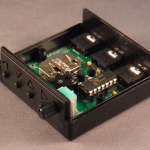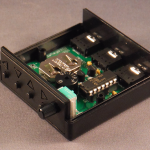This may at some point begin to sound like a commercial, but it really isn’t. I promise. I receive nothing from anyone in return for writing this kind of stuff; I do it just to hopefully help out fellow small business owners.
I know (and know of) a lot of owners of small businesses who regularly ship packages all over the US and worldwide. Most of them expend a lot of time and effort on shipping. I suspect this level of hassle is the norm for small businesses; I have talked to several large dealers and distributors who offer to be my exclusive distributor and relieve me of the crushing burden of shipping and order fulfillment. The truth is, order fulfillment and shipping take up a very small amount of the total time I spend running my business.
I know people who pack up each order, write the recipient’s name and address on the package (or print a label), drive to the post office and stand in line to have packages weighed and postage added. Ugh. Incredible. I used to do that too, but it was years ago. And filling out Customs forms for overseas shipments? Torture! At one time I seriously considered just NOT accepting any orders from outside the USA – -including APO/FPO addresses.
Others use on line tools like USPS’ Click-n-Ship to prepare labels. It’s a lot better, but the user interface is clunky, and you either spend time cutting and taping paper to packages, or pay through the nose for expensive labels. I looked into it, I even used it a few times. It’s only marginally better than the trip to the post office.
If you ship more than a few packages per week, you owe it to yourself to go with a postage supplier. I use Endicia, a choice I made after looking at them, Stamps.com and one or two others. Pitney Bowes was at the bottom of the list by a wide margin. I don’t remember the specific disadvantages of Stamps.com, but Endicia was the best suited for my needs. With any of these services, you pay for postage on line, print your labels with postage included, and drop your packages off or have them picked up.
So why Endicia instead of Click-n-Ship? With Endicia, I get a slight discount on postage and free delivery confirmation/package tracking. Their software is installed on my PC, and can communicate with a USB postal scale to automatically weight each package. I don’t use one simply because I know what 90% or more of my packages weigh, but when I see a good enough deal on a scale I’m buying one.
I use 4×6″ thermal labels. They’re available for very little money, since they’re produced in vast numbers for UPS, Fedex and others. I buy cases of 400-label rolls. They go into the used Zebra LP2844 printer I picked up for under a hundred bucks on eBay. In its former life it was used in a UPS store, and it’s given me three years of trouble-free service so far. The really nice part? I can print ANY kind of postage. First class parcel, Priority Mail, Express, and international — INCLUDING the Customs form. It’s SO nice to never have to fill out that stupid non-printer-friendly green form again! Some forms, like an Express International package, can’t be done on a 4×6″ label. For those I have the regular printer and USPS-supplied stick-on document sleeves. Endicia prints all the required forms with postage, ready to go.
For $15.95 per month I get the ability to print labels without the postage amount shown… so I don’t have to explain over and over to customers why I charged them $2.50 for shipping when the postage was only $1.93 (boxes, labels, printer paper and ink for the packing slip, packing material and gasoline are not free). I can get a refund on labels I don’t use; I can print return labels when a customer needs to return something. In short — my shipping is as close to effortless as it can be. And the post office employees love it when I drop off a tub full of packages WITH a USPS scan form so they don’t have to scan each package, just the form that puts each one into the system for tracking and delivery confirmation.
If you’re still writing out shipping labels, or if heaven forbid you’ve got a postage meter, you really owe it to yourself to check out Endicia. They’ll usually give you a free trial period, and you don’t need anything special to get started — you can use your existing printer and plain paper or a box of Avery labels form Office Depot while you try it out. Then you can develop your own process and streamline your shipping to take up less of your time and energy.




 My Droid 3 has been giving me fits for a while. The phone itself is fine… there doesn’t seem to be a hardware problem. A couple of months ago, though, it started nagging me daily to install a slew of app updates, including “Google Play Services”. Half the apps I use regularly finally refused to run at all until I installed Google Play, which I resisted because it wanted access to everything on my phone. All data, all history, location, email, everything. I finally had no choice but to dump the phone or install the damn thing, so I installed it (and the subsequent dozen or so other app updates). Since that time the phone has been plagued with odd behavior. It will periodically freeze up, require reboots, not be able to place a call for
My Droid 3 has been giving me fits for a while. The phone itself is fine… there doesn’t seem to be a hardware problem. A couple of months ago, though, it started nagging me daily to install a slew of app updates, including “Google Play Services”. Half the apps I use regularly finally refused to run at all until I installed Google Play, which I resisted because it wanted access to everything on my phone. All data, all history, location, email, everything. I finally had no choice but to dump the phone or install the damn thing, so I installed it (and the subsequent dozen or so other app updates). Since that time the phone has been plagued with odd behavior. It will periodically freeze up, require reboots, not be able to place a call for 